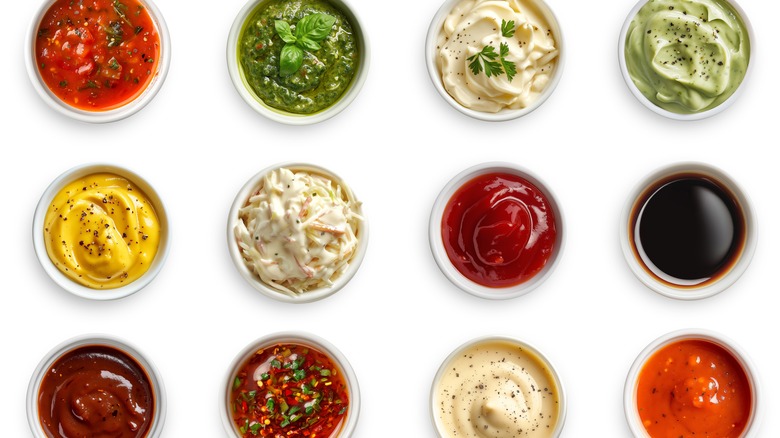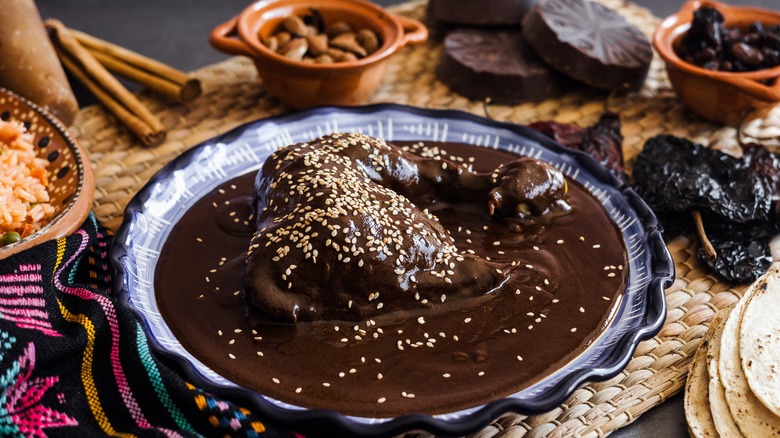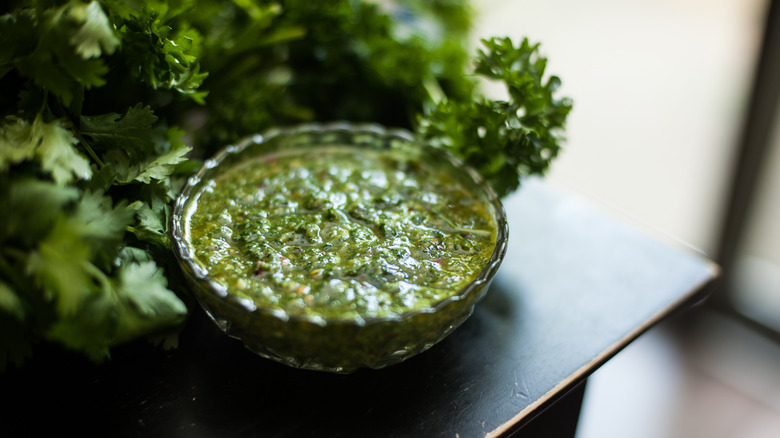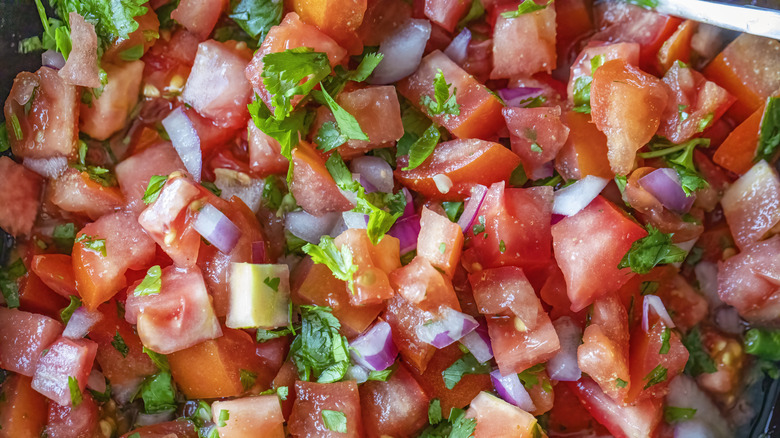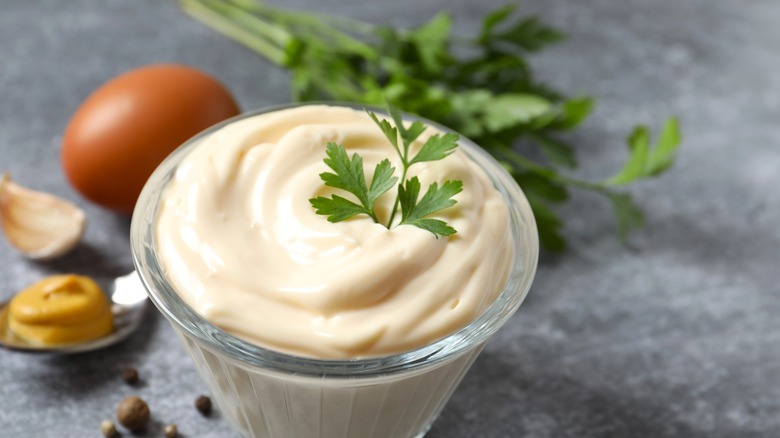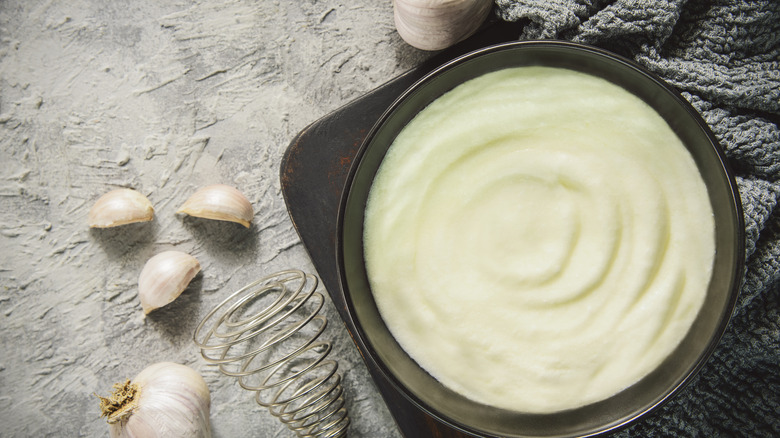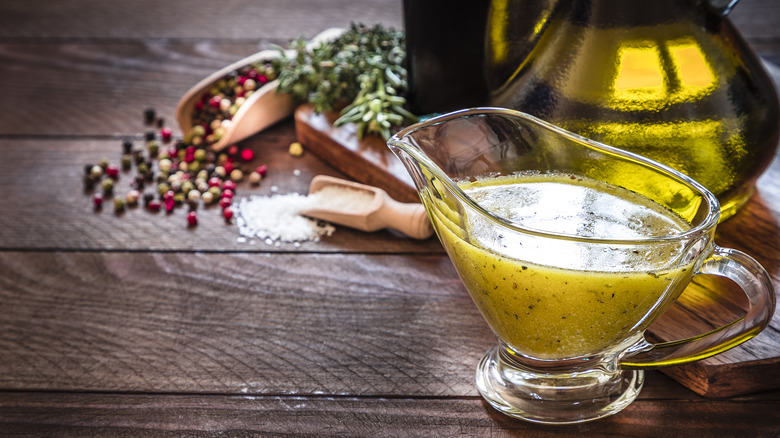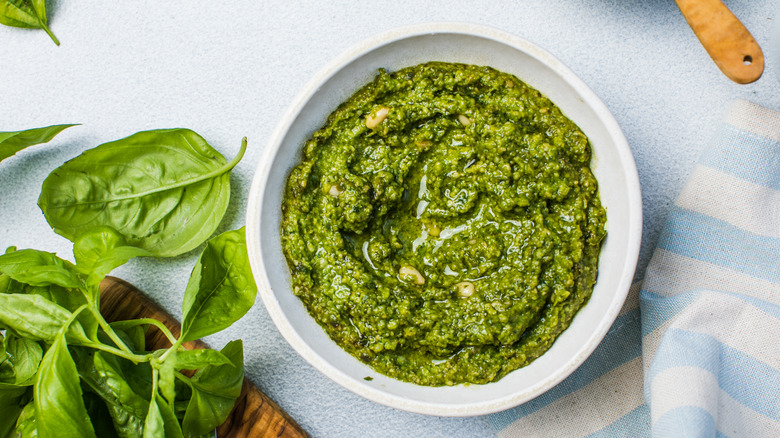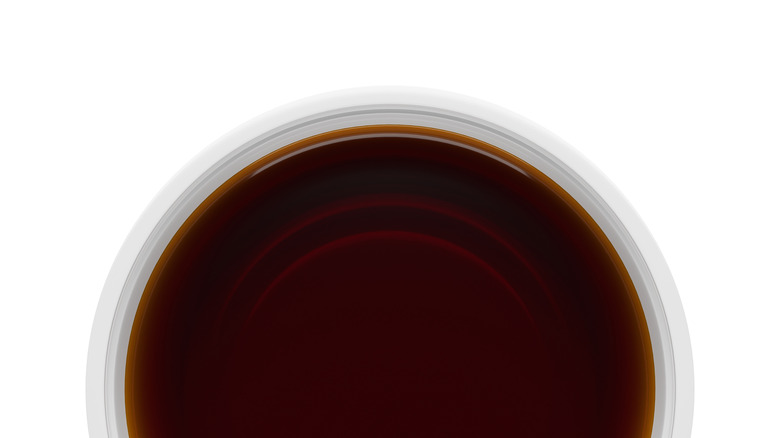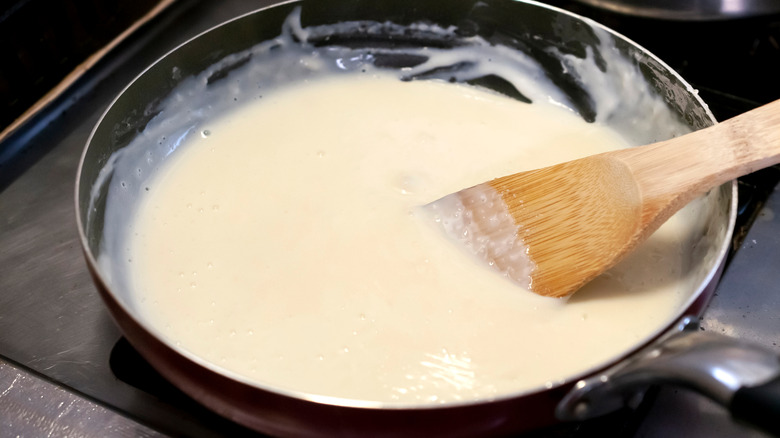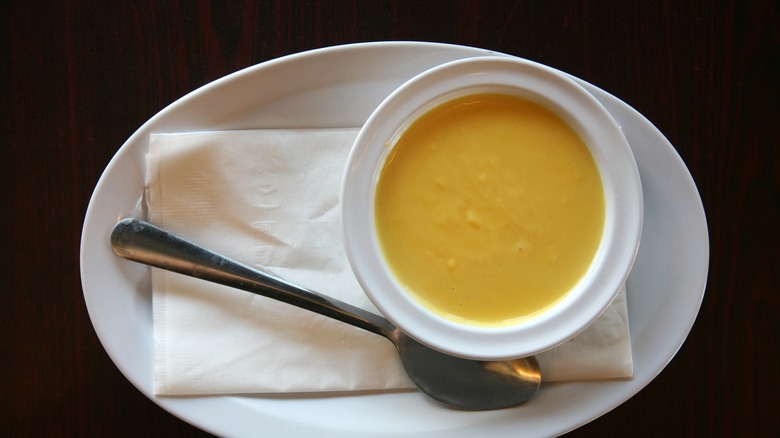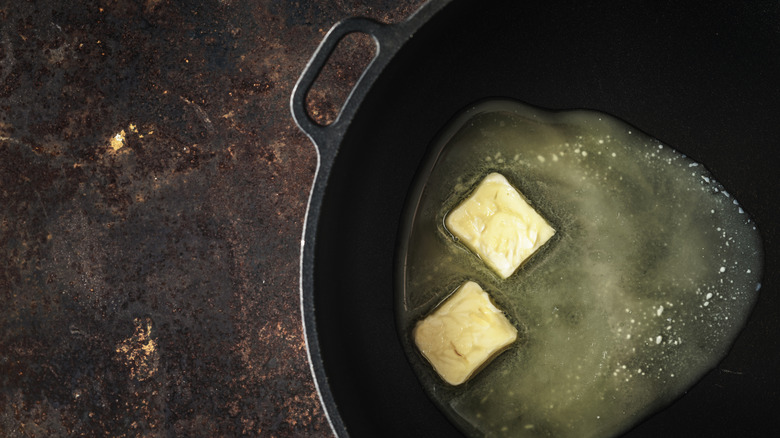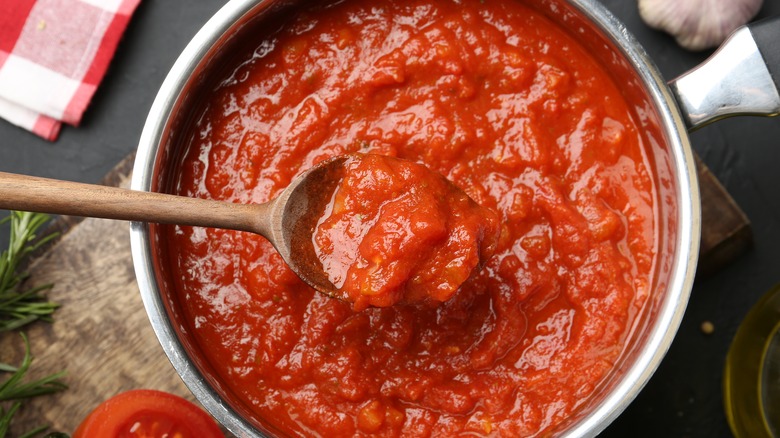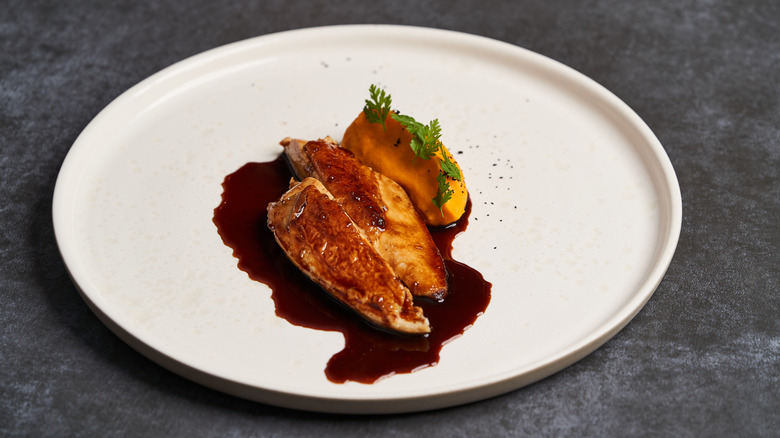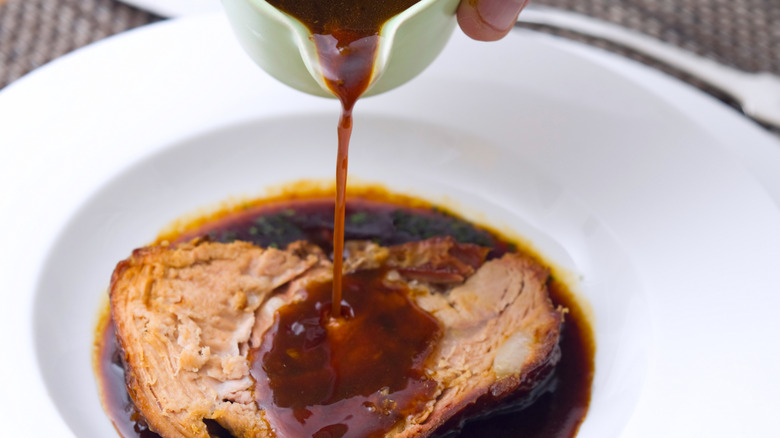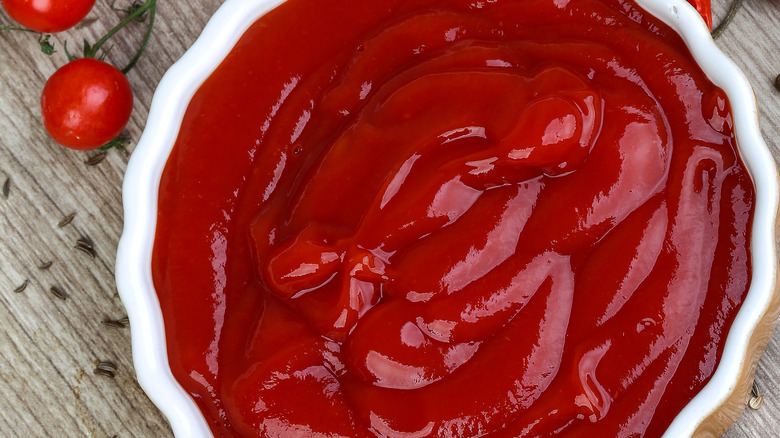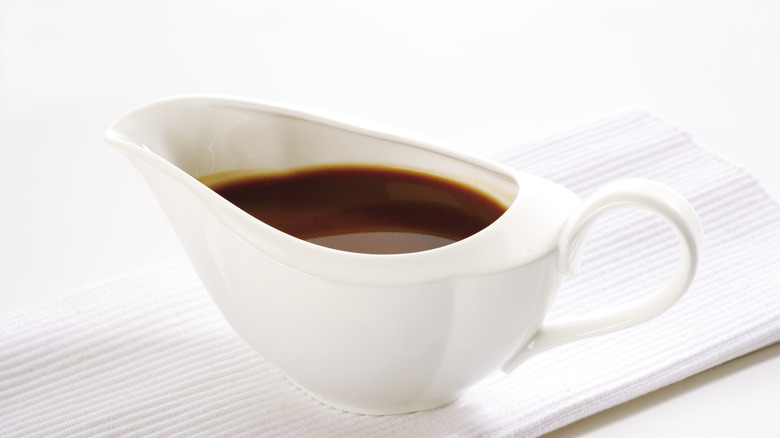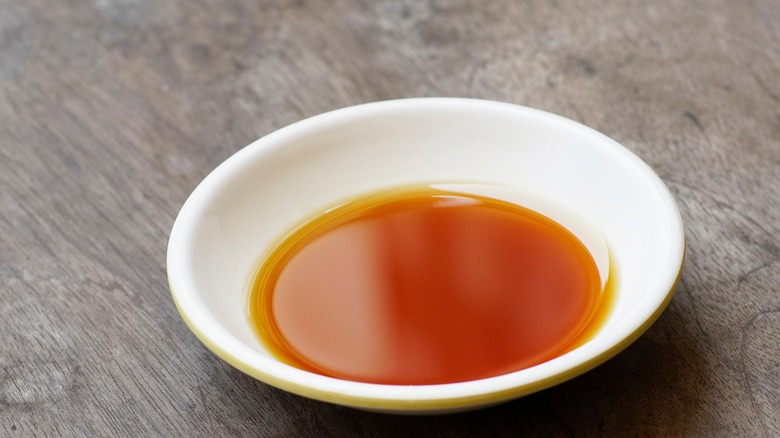Chefs Give Us 13 Sauces You Should Make At Home And 4 You Should Skip
We may receive a commission on purchases made from links.
It's no surprise that in France, the saucier is the most respected role in any kitchen brigade, or that the protein in Mexico's national dish is secondary to its sauce. A good sauce can make a dish; a bad one can render the recipe inedible. But since sauces can require loads of ingredients and time to prepare, these days, supermarket aisles teem with convenient versions: prepared sauces ready to add flavor to dishes in a snap. Some of these shortcuts are actually worthwhile, and some pale in comparison to the real thing.
Is it worthwhile to make your own soy sauce from scratch? How about homemade pesto? To figure out which sauces are worth mastering and which ones can be safely purchased with minimal negative repercussions, we asked expert chefs to weigh in. They spilled the sauce on the ones they always make from scratch and the store-bought shortcuts they actually prefer over homemade.
Make: Mole
While you can certainly find mole in a jar, it would be a shame to take a shortcut with this traditional Mexican sauce. There are as many mole recipes as there are cooks, from Puebla's mole poblano to central Mexico's green mole verde. Oaxaca, perhaps the heart of mole, boasts seven versions alone, including black mole or mole negro, made with deeply roasted chiles combined with nuts, seeds, plantains, herbs, spices, raisins, tomatillos, tomatoes, bread, and, yes, a touch of chocolate.
There's no getting around it: A true Mexican mole sauce is a time consuming endeavor. Rick Bayless writes that many home cooks making mole from scratch divide the recipe over the course of three days: one to roast and toast all the ingredients, one to simmer them together, and one, finally, to serve it with their protein of choice. But forget about any shortcuts: There's no comparing the store-bought stuff with this labor of love.
Make: Chimichurri
On the other end of the homemade sauce spectrum is chimichurri sauce, which comes together in as short a time as it takes to chop a few fresh herbs. This verdant Argentinian sauce is typically served with grilled proteins like the famous local beef, the brightness of the herbs and double-barreled punch of lemon and vinegar lending vibrancy to a sauce designed to counteract the slight bitterness of the char. "It goes well with any kind of proteins," says Executive Chef Guillaume Thivet, Chef at New York City's Grand Brasserie, of the sauce, "and it's packed of fresh flavors."
Since the very heart of chimichurri lies in the freshness of the herbs, it would be a shame to opt for a shelf-stable substitute. Luckily, though chimichurri is already a cinch to pull together at home, you can actually make it even easier for yourself by foregoing a knife in favor of a food processor. A few pulses, and this sauce is ready to enjoy.
Make: Salsa
Salsa is one sauce Yara Herrera, chef and partner at New York City's Hellbender, always makes from scratch. "Salsa cruda verde, salsa verde, avocado salsa, and guacamole are salsas I never ever buy at a store," she says, noting that while shelf-stable versions may be convenient, she says, "when you buy these at the store, they lose a lot of flavor." Luckily, they're not difficult to make. Her go-to is a simple salsa ranchera, made with blanched, peeled tomato, raw onion, serrano, cilantro, salt, and pepper. "It's a staple in my fridge that I enjoy cold or warm," she says.
Angelo Sosa, Executive Chef of Kembara and Tía Carmen in Phoenix, also loves making homemade salsas, especially because it allows his creativity free rein. "I used to always rely on buying salsa macha," he says, "but I was so inspired when I first moved to New York that I started making my own variations with everything from miso to super hots, to even an Asian rendition with Sichuan peppercorns." That said, he does have one shelf-stable salsa brand he loves. Tatemada, he says, is an all-natural brand making preservative-free salsas that "taste like a chef-driven product."
Make: Mayonnaise
This one might be a bit contentious. After all, whether they sit in Camp Hellman's, Camp Duke's, or Camp Kewpie, most people have strong feelings about mayo. And chef Chris Edwards of Nice's Café les Musiciens in Nice — and former vice-champion of Paris' best egg-mayonnaise competition — is one of them.
"I have never tasted a store bought mayonnaise that deserves to be named one," he says, noting that a homemade mayonnaise is a cinch to make. Simply whisk mustard with egg yolks and salt, then slowly drizzle in sunflower oil, whisking all the while to emulsify. Lemon juice and cold water can help stabilize the mayonnaise as you go, but should it break, you can always whisk the broken mayo into a new egg yolk.
Guillaume Thivet also believes in the power of homemade mayonnaise, with the caveat that there's a time and a place for store-bought. For certain recipes, he relies on Japanese Kewpie mayonnaise, which is richer than most American brands. For Thivet, it's "full of happiness and a very flavorful item." Yara Herrera, too, calls Kewpie her "go-to," noting it's perfect as a base for other flavors, like Hellbender's cilantro- or chipotle-spiked mayos.
Make: Homemade aioli and toum
On many a restaurant menu, the word "aioli" has come to refer to a zhuzhed up mayonnaise. But the true Provençal sauce is a horse of a different color. A true aioli begins with a generous base of raw garlic — the "ail" in its name — which is emulsified with egg yolk and olive oil until rich, creamy, and thick. A touch of lemon juice may be added to help stabilize the sauce, which is typically served as part of a grand aioli, a dish that pairs the sauce with poached white fish and loads of steamed veggies.
Lebanese toum is a similar, garlic-based sauce, often served with chicken. Bold and creamy, it, like aioli, relies on the fresh flavor and powerful aroma of raw garlic to give it its personality. For this reason, any store-bought versions simply pale in comparison. Luckily, a food processor toum recipe makes this already simple sauce even easier to master at home.
Make: Vinaigrette
Yet another simple emulsion worth mastering at home is vinaigrette. This staple salad dressing can be as simple as oil, vinegar, and salt, though some versions use mustard or egg yolk as an emulsifier for a creamier sauce. Either way, the simplicity of vinaigrette means that all of its power comes from the quality of the core ingredients, so it's nice to retain control rather than rely on an industrial, shelf-stable version, and making your own means you're free to choose any number of acids, oils, and seasonings.
Buying shelf-stable vinaigrette is all the more inexcusable seeing that this, of all sauces, may be the simplest to prepare. Simply pour all of the ingredients into a jar and shake; any leftovers are already ready for storage. You could also do as the French do and whisk a vinaigrette together in the bottom of your salad bowl before adding your greens. Chill until ready to serve, and toss just before plating so the greens don't wilt.
Make: Pesto
Store-bought pesto just doesn't hold a candle to fresh, if you ask Chris Edwards. "What is pesto?" he muses. "Chopped nuts or seeds with any herbs, loads of nice oil and maybe some parmesan." The importance of the quality of the ingredients means that opting for shelf-stable versions that cut corners and pack things full of preservatives is a shame. Guillaume Thivet agrees. "Pesto is one of the easiest spreads," he says. And making it yourself means you can harness the power of top-notch ingredients for a vibrant sauce exuding the flavors of summer.
But many still rely on shelf-stable pestos after disappointing and expensive experiments with homemade pesto, something that Trigg Ferrano says is a matter of relying on shortcuts when only the real deal will do. He claims that a pesto made in a blender is destined to be disappointing, so break out your mortar and pestle (from whence the very sauce's name is wrought) and use a bit of elbow grease to make this Ligurian sauce. Your pasta will thank you.
Make: Teriyaki
Teriyaki sauce is an ubiquitous Japanese seasoning beloved everywhere from top sushi restaurants to suburban American food courts. But the versions of teriyaki sauce you'll find in Japan are far simpler than American iterations. Stateside, teriyaki is often extra sweet thanks to the addition of pineapple juice and brown sugar. In Japan, the sauce is no more and no less than soy sauce, sake, sugar, and mirin, a sweetened cooking wine that adds a lovely balance of sweetness and acidity to the final sauce.
To make homemade teriyaki sauce, all you need to do is combine those four ingredients in a pot and simmer them until thickened and caramelized. The resulting sauce is delicious with any protein or simply drizzled over white rice. The amount of sugar and salt teriyaki sauce gives it a super long shelf life, and this, combined with its simplicity, means there's no reason not to make it yourself.
Make: Béchamel
When it comes to the classic quintet of French mother sauces, the most essential to master at home, according to Chris Edwards, is a béchamel. This sauce of milk thickened with a combination of flour cooked in butter known as a roux is a base for many a dish, from chicken pot pie to mac and cheese. Mastery, Edwards says, stems in large part to the ratio of roux to milk. "I think this is where many cooks develop a dislike to béchamel, as it can become gluggy," he says, noting that the right ratio — and the right cooking time — can give you the perfect texture.
Once you've got the base down, you can doctor it in many ways. Consider infusing the milk with clove, onion, bay, thyme or nutmeg before adding it to the roux, or adding a bit of tomato paste to the base. A touch of saffron "once it's all saucy," Edwards says, gives you a sauce that's perfectly paired with seafood. "If looking for a sauce for any poached meat," he adds, "add some of the cooking liquor to a slightly thicker béchamel, cook out to desired consistency, whisk in a little mustard, a touch of butter and freshly chopped herbs."
Make: Hollandaise
Once you've mastered the béchamel, Guillaume Thivet recommends turning your attention to another French classic: hollandaise. This sauce beloved to anyone who loves a good eggs Benedict is a warm emulsion of butter and egg yolks with a bit of acid to stabilize — usually lemon juice. Hollandaise is a bit more technical, however, than cold emulsions like mayonnaise. "You need to control the ratio of acid to butter," explains Thivet; otherwise the sauce will not stabilize. But once you've mastered this technique, you'll love having this in your wheelhouse.
One way you can play with it is by graduating to béarnaise, a similar sauce relying on white wine vinegar in place of lemon and seasoned with shallots and tarragon, with its anise-adjacent aroma. The resulting sauce, says Thivet, is "delicious on steaks, chicken, lamb, sandwiches, and any other proteins you can think of," and it's sure to wow any dinner guests.
Make: Brown butter sauce
Butter is the base of many a rich, decadent sauce, but it can also become a sauce in and of itself with the right care and attention, according to Chris Edwards. After cooking it slowly, whisking all the while, the milk solids in the butter become caramelized and toasted, giving off a fragrant, nutty aroma. At this point, he suggests, you can infuse the butter with a fresh herb like woodsy sage, rosemary, or savory. Cook until slightly crisped, then stop the cooking with lemon juice to keep the butter from burning.
All that's left to do is season the resulting sauce with fleur de sel and freshly ground pepper. In just ten minutes, you will have created the perfect sauce for steak, chicken, or a panful of seasonal wild mushrooms. Brown butter also goes wonderfully with fresh pasta, particularly when paired with slightly sweet winter squash or sweet potatoes.
Make: Tomato sauce
With so many jarred pasta sauces on the market, many of which are cheaper alternatives to homemade tomato sauce, it can be difficult to resist their siren call. But Guillaume Thivet implores home cooks to do just that. Making homemade tomato sauce is "easy," he says, and what's more, "you can modify to your liking at any time."
Using fresh produce, he says, will make a world of difference. Begin with the best-quality fresh or canned tomatoes, adding a carrot if needed to boost the sweetness of the resulting sauce. Infuse the sauce with garlic or chile, basil or onion, or keep your sauce simple to let the tomatoes sing. And if the fresh flavor of homemade tomato sauce isn't quite enough to push you out of camp store-bought, remember: Homemade tomato sauce can easily be made in big batches and frozen or jarred for another day.
Make: Chicken jus
One of the secrets of restaurant dishes that are so much more delicious than home-cooked is the reliance on homemade stocks. These flavorful liquids are a constant in a good restaurant kitchen, transforming offcuts and bones into a rich flavor enhancer that only becomes more delicious the more it's reduced. Cooked down into a jus, demi-glaze, or glace, this bounty add loads of richness to other base preparations and can even be used as a finishing sauce all on its own.
But a good jus, cautions Guillaume Thivet, can be time-intensive to make and even expensive, depending on the base meat you use. But by relying on inexpensive chicken, a bit of time can coax out a phenomenal amount of deep, poultry flavor. The next time you roast a chicken, save the bones for homemade stock, and reduce it down to concentrate it. The resulting flavor, Thivet says, is "priceless."
Don't make: Veal jus
Guillaume Thivet is definitely a fan of jus and demi-glace in a restaurant kitchen, but when it comes to home cooks, he's of two minds. "If you have a lots of time and money it is absolutely worth it and rewarding," he says. But ultimately, the endeavor can be time consuming and pricey. And this holds double when you begin with a more expensive meat, like veal.
Veal is far more expensive than beef, and what's more, it can be divisive. Commodity veal is raised on factory farms, with calves historically confined to small crates to help make the meat even more tender. While in 2016, the USDA introduced legislation to encourage more humane treatment of veal calves, the fact remains that for many, consuming veal is a difficult prospect to stomach. Compounded with the time it takes to reduce the cooking liquid down to a syrupy jus, it might be best to leave this one to the pros.
Don't make: Ketchup
Did you know that ketchup wasn't always made with tomato? Originally, ketchup recipes began as something closer to a fermented fish paste. We've come a long way to make it to Heinz's sweet, sour, and savory recipe.
While there's a bounty of ketchup recipes available online, ketchup is one arena where homemade can actually border on disappointing. This is in large part due to the fact that we've grown so accustomed to the classic, in all its glossy, corn-syrup soaked glory. To get the right texture, you'll need to rely not only on uncommon ingredients like xanthan gum, but also on a very time-intensive process. It just takes a very long time to achieve the ketchup consistency and flavor we're now used to, so unless you have a whole day to kill, you might want to skip making this sauce.
Don't make: Sauce espagnole
Sauce espagnole is a classic French sauce from the 19th century, a complex combination of mirepoix sautéed in lard to which a brown roux and brown veal stock are added, joined by a reduced, concentrated tomato purée. It's an absolute flavor explosion, when made correctly, but for Chris Edwards, it's a creation best left to the pros. "A sauce espagnole is not really worth getting involved in unless it is made with 10 litres of fond brun (previously homemade) with the addition of half a kilo of roux plus vegetables, lard, etc." he says.
The attention and time required to master sauce espagnole are intense, "and this is purely to achieve a base sauce," he adds. While the project may be "incredibly satisfying" and even "honorable," he continues, it "makes much more sense in a professional kitchen where it is going constantly in the background."
Don't make: Fish sauce or soy sauce
If you use a lot of fish sauce or soy sauce at home, you may get the urge to try to craft these store cupboard staples — especially if you've already eradicated store-bought teriyaki sauce from your shopping list. But for Jon Kung, author of "Kung Food: Chinese American Recipes from a Third Culture Kitchen," this would be an error. "Fish sauce and soy sauce are two laborious and time-consuming ingredients to make," they say, noting that both require quite a lot of special equipment and know-how. This, they say, is down to the fact that both are made by way of fermentation, which requires quite a bit of waiting time and mastery to get just right.
Ultimately, it's "not worth the effort if you don't know what you're doing," they say. "I'm no more tempted to make my own soy sauce or fish sauce than I am to make my own olive oil from scratch."
